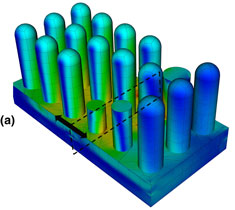Article contents
An integral equation based domain decomposition method for solving large-size substrate-supported aperiodic plasmonic array platforms
Published online by Cambridge University Press: 17 March 2016
Abstract

We propose a surface integral equation simulation scheme which incorporates the integral equation fast Fourier transform accelerative algorithm and domain decomposition method. Such scheme provides efficient and accurate solutions for substrate-supported non-periodic plasmonic array platforms with large number of building blocks and complex element geometry. The effect of array defects can be systematically and successfully studied taking advantage of the considerable flexibility of the domain decomposition approach. The proposed model will be of great advantage for fast and accurate characterization of graded-pattern plasmonic materials and metasurfaces.
- Type
- Plasmonics, Photonics, and Metamaterials Prospective Article
- Information
- Copyright
- Copyright © Materials Research Society 2016
References
- 5
- Cited by





